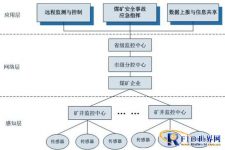
Application of Internet of Things in Coal Mine Safety Production
[ad_1]
In order to ensure coal mine safety production and improve the level of coal mine safety supervision, the article proposes the coal mine safety production IoT system, and elaborates the design and implementation of the system plan. The design and implementation of the system are divided into three levels: perception layer, network layer and application layer, which can realize functions such as data collection and detection, on-site monitoring and control, and remote monitoring and command.
1 Introduction
Although my country’s coal mine safety production has made considerable progress, its overall level is still relatively low from a horizontal comparison, and there is still a big gap compared with the international advanced level of coal mine safety production, especially serious and serious coal mine safety accidents. Has happened. How to use information products to ensure the safety of coal mine production, prevent accidents, quickly and accurately locate after an accident, and conduct emergency rescue and repair has become a major issue before us.
2 Problems in coal mine safety monitoring and monitoring
The problems in most of our country’s coal mine safety monitoring and control systems cannot be ignored, mainly as follows:
(1) Underground operations in coal mines are far away from the ground, the terrain is complex, the environment is harsh, and communication with ground personnel is inconvenient and untimely. It is difficult for ground personnel to dynamically grasp the distribution and operation of underground personnel in a timely manner;
(2) After a coal mine accident, the efficiency of emergency rescue and safety rescue is low, and the search and rescue effect is poor;
(3) Most coal mine safety monitoring and monitoring equipment is outdated and aging, cannot adapt well to the underground environment, and cannot well meet the needs of coal mine safety production;
(4) The existing coal mine safety monitoring and monitoring systems are divided into systems, and there is no unified standard and interface, which has caused problems such as missing data in the monitoring project and the failure of normal communication between systems, leading to potential safety hazards.
3 Scheme design of coal mine safety production IoT system
In response to the above problems, this paper proposes a coal mine safety production IoT system, which is designed in accordance with the requirements of unified planning, unified deployment, unified management, unified interfaces and standards. The design is divided into three levels, namely the perception layer, the network layer, and the application. Layer, as shown in Figure 1.

Figure 1 The overall model of the coal mine safety production IoT system
The perception layer is mainly composed of sensors, and the data detected by the sensors are transmitted to the control computer through the communication module to realize data detection and collection. The perception layer includes: 1) data collection equipment such as sensors, such as video monitoring and sensing equipment installed in ground wellheads, coal platforms, underground and other places; 2) sensor network before data is connected to the gateway, including data from mine sensing equipment Access, transmission and aggregation.
The network layer realizes real-time and accurate transmission and interaction of object information through the integration of various telecommunication networks and the Internet. The network layer adopts a three-level structure, namely, coal mine enterprises, municipal sub-control centers, and provincial monitoring centers. With the mechanism of “graded supervision and graded response”, the Internet of Things architecture for coal mine safety production is built to realize the monitoring and supervision of coal mine safety production. The network layer includes: 1) uploading of mine monitoring data; 2) dedicated data lines for coal mining enterprises; 3) dedicated broadband data lines for provincial monitoring centers, coal groups and municipal sub-control centers. The application layer uses various intelligent computing technologies such as cloud computing and pattern recognition to analyze and process massive data and information, and implement intelligent control of objects, including remote monitoring and control, emergency command for coal mine safety accidents, information uploading and sharing, etc. . The application layer includes: 1) the construction of host and storage systems; 2) the display, dispatch, and command systems of coal mine enterprises, municipal and provincial monitoring centers; 3) standardization of information reported by coal mine enterprises; 4) construction of portal websites and security systems. According to the above design, the overall network diagram is shown in Figure 2, and the following goals are achieved:

Figure 2 Network diagram of the coal mine safety production IoT system
(1) Timely monitoring, analysis and control of the operation conditions of underground gas, wind speed, equipment start and stop, etc., and at the same time transmit the above monitoring data to the coal safety production management department at all levels through the public telephone network, wireless network, and optical fiber and cable;
(2) The dynamic management of coal mine safety production supervision and supervision, real-time understanding of coal mine safety production work status, and keeping abreast of relevant safety technical working parameters of coal mines (including safety technical parameters, safety supervision and supervision requirements data), and all coal mine sites can implement effective For the daily safety management of coal mines, the coal supervision department can implement effective supervision and management of the safety production work of various coal mines;
(3) When an accident occurs in a coal mine, it can provide the basic technical data of the coal mine site, the emergency response plan of the enterprise and the government, the distribution information of the accident rescue resource, etc., and provide the corresponding basic information support for the municipal and provincial public safety emergency command system , Provide technical support for scientific decision-making and effective rescue.
[ad_2]



